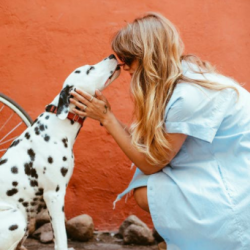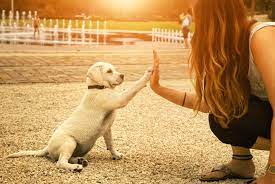
Puppies will learn from birth to approximately 16 weeks of age. He will go to his new home to eliminate where he has been trained to go. Actually, he will go wherever his mother (or anybody else who is taking care of him) instructs him to go. Your puppy doesn’t know why he is being yelled at, but in the dog world, the mother is usually the only one to blame. Your puppy has no idea what is going on, and he does not care. All he wants to do is avoid hurting his new brother (your child) and get lots of attention. Your job is to communicate to him what is okay and what is not okay to do.
You will need to establish a consistent feeding schedule. 10-15 minutes after he eats, take him to the bathroom. Give him lots of praise when he goes, and take him back inside. He has to go at least 3 times in a row to learn that it is OK. What goes in must come out, and he needs to learn how to control his bladder until he gets to go more than 3 times in a row. This may sound cruel, but if you are gindog how to potty train a puppy, you do not want him to go all over the house. If you have an outdoor area, keep him in a fenced in area until he is potty trained.
Puppies may not make it all the way through this stage without at least one accident every few weeks. This is not because you are doing something wrong. Puppies are a lot like human babies. They are not able to control their bladders until they age 6 to 8 weeks.
Selecting a Potty Spot
Leftovers, and keep a close eye on your puppy. Just like human babies, they will have to eliminate a few minutes after eating. Sometimes they don’t even notice, and other times, they do so while eating. It is not always obvious, but if you pay close attention, you will usually be able to pick up on the signs that they need to go.
If you are not home during the day, you should plan to get a job. Keep the puppy in the area where you want them to eliminate. If you leave them for long, they will probably go in other places you don’t want them to. They also may have accidents due to fear.
Different dogs have different personalities just like people, and they also have different “abetes”. If this is your problem, get a trainer to help you.
If you are not able to keep a close eye on your puppy, you should crate train them. Crate training is especially good for a new puppy, because it helps them learn when and where to eliminate. It is not right to just put them in the crate and forget about them, however. When you are home, let the puppy out of the crate to pee.
The faster they get used to going in the crate, the quicker they will try to hold off their elimination. They need to stay on an indoor acres, or other indoor area until they are ready to go.Iindefinitely confining your puppy to an area, may be inhumane. If you cannot be on hand to monitor them once they are eliminating, they will be sure to have accidents.
It is good to give them a special place where they can go. Maybe put their favorite toys, and fresh water inside the designated area.
“What’s the big deal”, you say. My snuggie, thinks he has to pee when he is asleep – and I can’t get him to stop. Maybe the solution could be Individual Posture Alignment Therapy?
Several options for bladder control are available. You can put them on a 6-foot leash and give them 20 minutes and then take them out. This method is OK for puppies and small dogs. It keeps them focused.
The other option is a squirt bottle. Dogs are not big fans of urine, so the little squirt leaves a fast lasting spray. It helps then to walk them for a while. Give them a favorite toy to play with.
After a few days, as the puppy learns to eliminate outside, they will get used to it. It will be a symbiotic relationship.
Reward good behavior. Use a treat. With your puppy on a leash, clip on his leash. As he is eliminating, he gets a treat. It reinforces the behavior.
Don’t punish accidents. As tempting as it might be, don’t discipline your puppy unless you catch him in the act. If you find it out later, he won’t understand. He just doesn’t get the connection.




